Apples
(4-6 mos.)
Extremely rich in important antioxidants, flavonoids, insoluble and soluble fiber, their nutrients promote good health well into adulthood. Cooked apples are often baby’s first food; rinse well and leave skin on to get all the benefits. Use the Empire variety to make pink applesauce; it is always good to stimulate your child’s appetite with different colors, textures or flavors.




















